Photo: 5020 Records
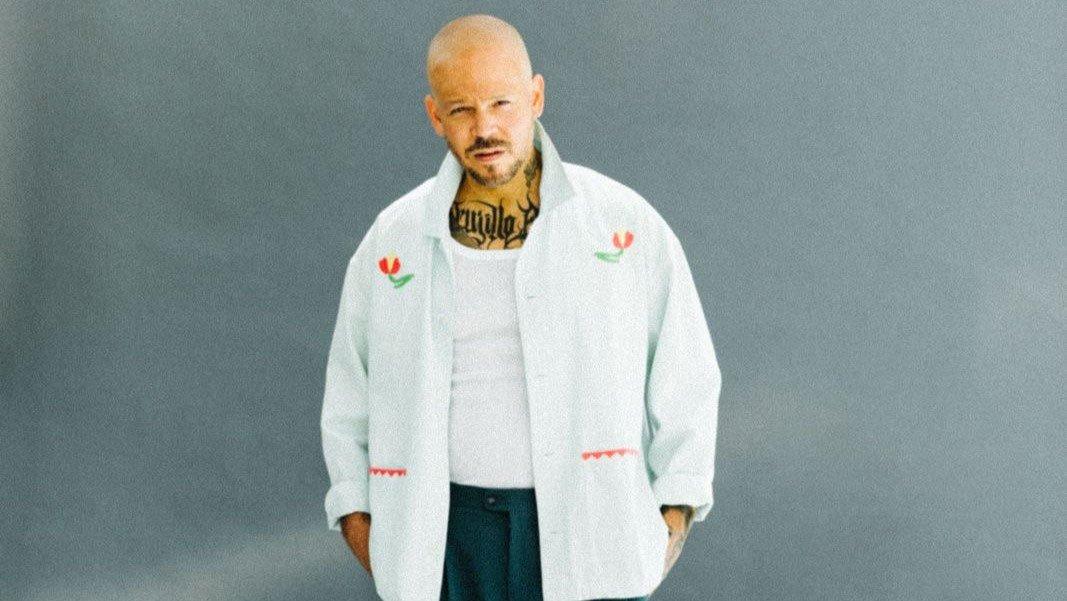
interview
Inside Residente's 'Las Letras Ya No Importan': How His New Album Shows The Rapper In Transition
"It’s an album that marks a musical transition for what’s coming for me," Residente says about his sophomore record, 'Las Letras Ya No Importan.'
Puerto Rican rapper Residente wants to embark on new adventures.
The artist born René Pérez Joglar has dreams of directing movies and acting, writing books, and making for pleasure — not to pay the bills. These goals reflect a new attitude, one resulting from time spent reflecting on the passage of time and the presence of death.
Residente's sophomore album, Las Letras Ya No Importan (Lyrics No Longer Matter), echoes this transitory period. An extensive body of work, featuring 23 tracks, with several songs surpassing the five-minute mark. Las Letras is an act of deeply intimate rebellion.
"It’s a very personal album, and I sought to connect with myself in many moments throughout," Residente tells GRAMMY.com.
While Las Letras explores topics already a hallmark of his music — the music industry, political systems, Puerto Rico — it's also exceedingly vulnerable. The 28-time Latin GRAMMY and four-time GRAMMY winner opens up about depression and personal relationships, and confronts mortality.
Lead single "313" is inspired by Residente's late friend Valentina, whose voice appears in the first interlude. As Residente recounted to El País of Spain and GQ Spain, Valentina was a violist, and the last messages they exchanged on WhatsApp were at 3:13.
The song begins with a French verse, fulfilling Valentina’s wish, expressed in the first interlude, to do something in that language. "Les paroles n'ont pas d'importance," (words no longer matter), a female voice whispers, followed by a spectacular string arrangement.
Residente revisited older works during this period of creative transition, and the record features previously released tracks "René," "This Is America," and "Quiero Ser Baladista."
Las Letras Ya No Importan features many collaborations, with actress Penélope Cruz, Spanish singer Silvia Pérez Cruz, Rauw Alejandro, Ricky Martin, Christian Nodal, Arcángel, Jessie Reyez and others making appearances. Hip-hop icon Busta Rhymes is featured on "Cerebro," while Big Daddy Kane makes an appearance on "Estilo Libre" with Vico C.
GRAMMY.com spoke with Residente via Zoom about the process that led him to his second album, the symbolism behind "313" and the artistic connection to Spain.
This interview has been edited for length and clarity.
What inspired you to create Las Letras Ya No Importan?
It’s an album that marks a musical transition for what’s coming for me. It feels diverse; it also has songs with which I may not feel as connected [to] now because several years have passed since I made them. There are newer songs with which I do connect, which have a bit more to do with the way I want to start working on my music in the future.
"René" is part of this album, even though it came out four years ago. This is an album I was going to release during the pandemic.
We have "René," which is very personal; we have "313," which I also feel is personal; then "Ron en el piso," [a song about the passage] of time, the collaboration with Nodal ("Pólvora de Ayer") also touches on the theme of time, of enjoying everything.
You confront death in several songs. In "René," you sang about losing a friend; in "Ron en el piso," you see your funeral; and in "313," you draw inspiration from your late friend Valentina. What is it about death that inspires you?
It’s something I’ve been going through in recent years. I lost many people I love, and it made me much more reflective when it comes to understanding time, the things I want to do, and the things I’ve stopped doing.
That’s why I’m also transitioning to cinema. I’ve always wanted to make films, directing, being behind the scenes, not being on stage. I’m crazy about dedicating myself entirely to that.
I discovered acting now in a movie I starred in [In the Summers] that won the Jury Award at Sundance. When I saw it, I didn’t know I was the protagonist until I watched it. [The film] encouraged me to follow that too, and I’m going to want to act, direct; I want to dedicate myself to that for a while fully.
The album has a lot of life, and even though the lyrics no longer matter, you still have much to tell. You already said the album is very personal, but how would you describe it?
I can describe it in two years, not right now. It’s transitional. That’s what happened with Calle 13; everything was a musical and lyrical change from the second album onwards.
Residente represented a fusion of world music and rap. Now, in this one, I’m using a lot of strings, cellos, and double bass. I’m going to experiment a lot with different instruments in different ways. I’m going to be creative without the need to balance the album.
What’s coming next doesn’t have that artistic pressure. The only artistic pressure I want to have is to do the highest I can, which happens organically, not feeling pressured but naturally.
I want to do art as I did in college [at Savannah College of Art and Design]. I was never thinking about people or trying to convince anyone, and I was completely free, and that’s what happened with "313." I had the freedom I always wanted to have.
There’s substantial symbolism in "313," from the faceless dancers, the color pink. What was your vision with the visuals?
The dancers represent time. Penélope [Cruz] can represent many things, from life to Valentina, my friend, who inspired me to make the song. Penélope controls me, holds me, flies me, brings me back, and then I decide to control my life and time. That’s why I raise my hands, and everyone raises them, and time is running out, and then you see a sunset.
Sunset marks the end of something. The colors of the costumes also have some dusk elements. You can see at the end when I’m disappearing; it fades and blends with the end of the sunset.
These are decisions I make that are both aesthetic and technical. I put masks on the dancers because I liked it aesthetically. It also helped me speed up the process with makeup. I had to find creative ways to maintain the video’s aesthetics and make everything more agile because in filming, everything is time, and I had little of it.
What’s the idea behind the song "Las Letras Ya No Importan?"The arrangement is magical, with a numerical sequence from one to eight in different languages and a voice spelling of the alphabet.
That was the initial track. Before "313," I had this idea that I dreamed of with some basic notes, and it turned into something big.
There’s a voiceover of Penélope [Cruz] that says that we were eight [people in the studio], we are on an 8th street in New York, in studio B, which, if you look at it, it resembles the number 8. Everything connected with eight and [that number] also at a time level can mark infinity. So, I connected all that with the immensity of letters and languages. That piece’s runtime is five minutes. I think it’s pleasurable. I like that music, which resembles what I want to do.
Leo Genovese, an excellent musician and musical genius, made the arrangements. I greatly respect him.
In "Cerebro," you showcase your skill and vocal speed; what was it like collaborating with Busta Rhymes, whose own flow is iconic?
We met, and he loved the concept of what I was working on. He was a very humble, good person to me. After we met in person and talked for a while, he went to write after I sent him everything I had written in English.
I created ["Cerebro"] a while ago…. That’s why I tell you that the album has several concepts that I had to let go of because it was too much, and a lot of time had passed. I had a previous concept when I released the song "René" [in 2020], which is why it’s on the album. [At that time] I was working with the brain waves of different animals and people, and I made music with those brain waves.
This song ["Cerebro"] is part of that, and that’s why it’s called "Cerebro." The album was originally going to go that route. Then I didn’t do it; maybe I’ll connect to it in the future because I loved that idea.
What has Spain meant to you? The country has been so prominent in the trailers you’ve released and in the collaborations in your latest songs.
I've been making frequent trips to Madrid. This past year, I was there a lot; I was more in Madrid than at home. I traveled, wrote, and filmed videos like "Problema cabrón" and "313."
I grew up with Spanish cinema by Almodovar and a bunch of directors I admire, and I wanted to collaborate with the actors I grew up watching in movies.
This album has many personal elements, and cinema is very intimate for me. I saw [Penelope Cruz] in [the movie] Abre los ojos when I was a kid; working with her now is a dream. The same goes with Javier Cámara and Najwa (Nimri) [who is in the film] Lovers of the Arctic Circle by Julio Medem. I saw all these people, and now being able to collaborate with them, be friends with them, talk to them is a dream. Everything is very connected to my life.
Erick The Architect Steps Into A New World On 'I’ve Never Been Here Before'
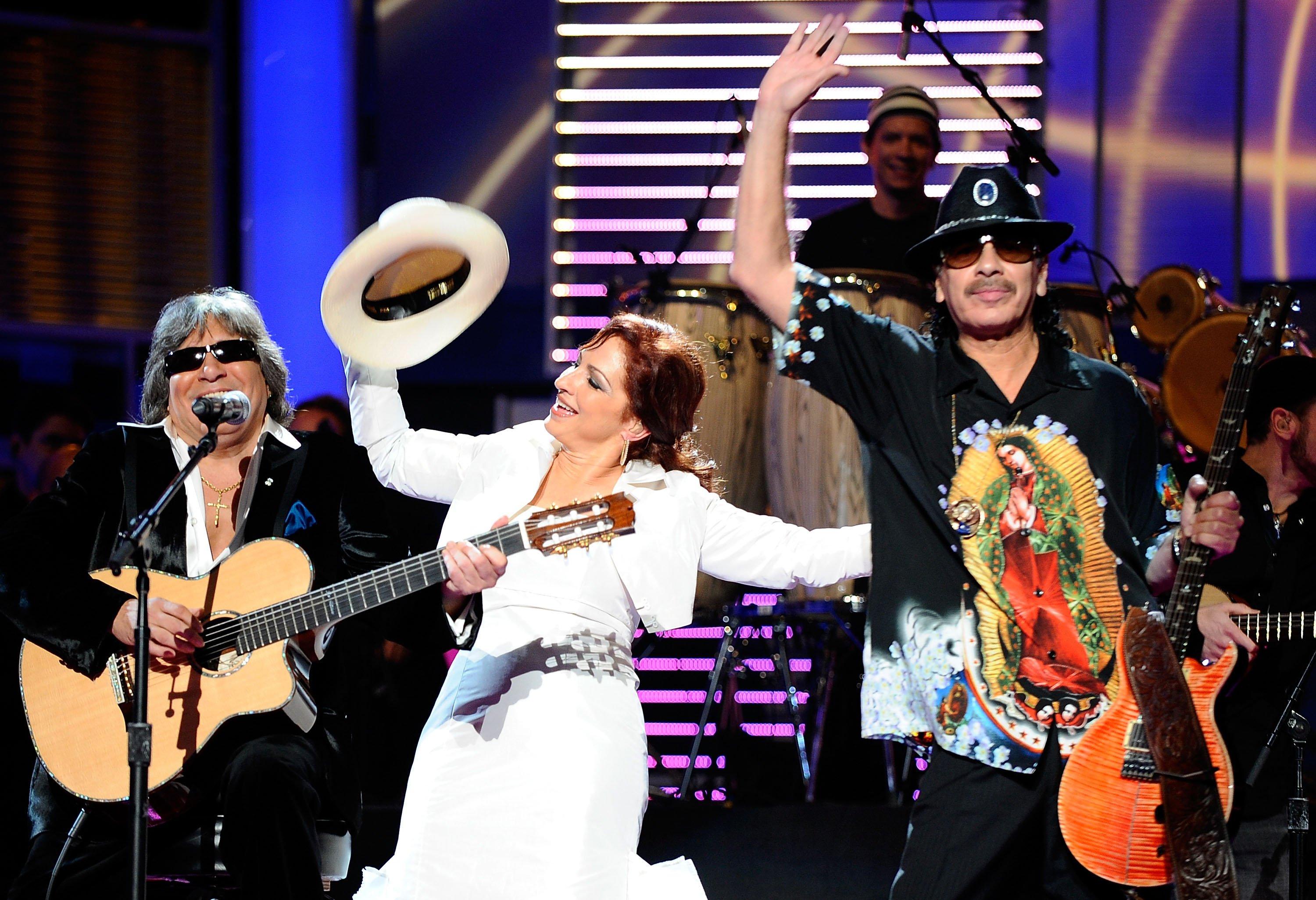
Photo: Michael Caulfield/WireImage
list
25 Songs That Defined The Latin GRAMMYs: A Playlist
Ahead of the 2024 Latin GRAMMYs on Nov. 14, revisit some of the ceremony's most resonant songs — from Celia Cruz's "La Negra Tiene Tumbao" to Juan Gabriel's "El Noa Noa" and the forever earworm "Despascito."
In the fall of 2000, the Latin GRAMMY Awards made their television debut live on CBS, making history as the first prime-time bilingual broadcast to air on network TV.
The ceremony arrived right on time: the "Latin Explosion" was just beginning, and everyone was taking notice. Marc Anthony had risen to No. 3 on Billboard’s Hot 100 with his smash hit, "I Need To Know (Dímelo)," Ricky Martin’s 1999 performance at the GRAMMY Awards catapulted him to international success, and Carlos Santana was in the midst of a comeback with his No. 1 collaboration "Smooth," with Rob Thomas. Jennifer Lopez, Enrique Iglesias, and rising crossover star Shakira were all adding fuel to the fire.
It was this rising movement that had prompted the establishment of The Latin Recording Academy in 1997 and, by 2000, the idea of having their own ceremony seemed like a no-brainer. Hosted by a rotating cast of stars including Gloria Estefan, Jennifer Lopez, Andy García, Jimmy Smits, and Antonio Banderas, the show was broadcast to nearly 9 million viewers. And while it may have been expensive to orchestrate, then-president of The Recording Academy, Micahel Greene, told Billboard that it was "the best investment the academy ever made."
Since then, the show has become known as the Biggest Night In Latin Music, the ceremony regularly brings together artists and fans all over the world, drawing in 18.9 million viewers in 2024. This year, the Latin GRAMMY Awards will be held on Nov. 14, broadcast from Miami, Florida.
Read more: 2024 Latin GRAMMYs: See The Full Nominations List
Ahead of the 25th Annual ceremony, revisit 25 songs that have defined the Latin GRAMMYs. As you read, press play on the playlists below.
"Oye Cómo Va" — Ricky Martin (2000)
Just a few months before the Latin GRAMMYs’ inaugural ceremony, the Latin music world suffered the loss of Tito Puente, the legendary Puerto Rican bandleader and composer. To honor his legacy, Ricky Martin kicked off the show with an electric rendition of Puentes’ iconic 1962 cha-cha-chá song, "Oye Cómo Va," (later covered by Santana to great success in 1971), as part of a medley performed alongside Celia Cruz and Gloria Estefan.
It had only been a year since Martin had taken the world by storm with "Livin’ la Vida Loca" — the lead single of his English-language debut, and the track that helped the "Latin explosion" of the 2000s take off. With this performance, Martin proved that while he was chasing down crossover success, he would always celebrate his roots.
"Fíjate Bien" — Juanes (2001)
It might be hard to imagine a time before Juanes was an internationally-renowned Latin rockstar. But back in 2001, the Colombian singer was a relatively new solo act, having disbanded his rock band, Ekhymosis in 1998. His debut album, Fíjate Bien, didn’t make waves on the charts outside of Colombia, but it did catch the attention of The Latin Recording Academy. The singer entered the ceremony with seven Latin GRAMMY nominations, and left with three wins, including Best New Artist.
His success that night prompted him to head straight back into the studio with more than 40 demos for producer Gustavo Santaolalla. These sessions would eventually become Un Día Normal — Juanes’ international breakthrough. To date, Juanes holds the record for second-most Latin GRAMMYs won, with 27 total.
"La Negra Tiene Tumbao" — Celia Cruz (2002)
Sporting a gravity-defying white and blue wig and matching sapphire-sequined gown, Celia Cruz delivered her final performance at the award show in style. That night, the 76-year-old salsa superstar was up for five awards, taking home Best Salsa Album for her release, La Negra Tiene Tumbao.
Its title track of the same name fused the music she was most known for with reggae and hip-hop, and marked her last major hit before her death the following year in 2003. With a dazzling laugh and a booming voice, Cruz accepted her award saying, "Damas y caballeros, excuse my English, but I love you," exiting the stage with her signature catchphrase: "¡Azúcar!"
"En el 2000" — Natalia Lafourcade (2003)
Though she didn’t take home an award in 2003, Mexican singer/songwriter Natalia Lafourcade left her mark with her imaginative and funky breakout single, "En el 2000." The accompanying album, her self-titled debut, gained critical acclaim for its combination of alternative pop, bossa nova, and Latin rock sounds.
Up for three awards that year, including Best New Artist, Lafourcade went on to become the most-awarded woman in Latin GRAMMYs history, with 17 awards to date.
"Casi" — Soraya (2004)
After being diagnosed with Stage III breast cancer in 2000, the Colombian American singer made her triumphant return to the music industry with her fourth album. The self-titled record featured two of her biggest hits, "Solo Por Ti" and "Casi." Each of the album’s 12 tracks were written, produced, and arranged by the singer, earning her the first-ever Latin GRAMMY for Best Singer-Songwriter Album, and her first and only Latin GRAMMY.
After receiving her award, Soraya said, "I’m standing here as a fighter … hopefully paving the way for many other female singer-songwriters."
"Gasolina" — Daddy Yankee (2005)
It would be difficult to overstate the global impact of Daddy Yankee’s megahit, "Gasolina" — the first reggaeton song to be nominated for a Latin GRAMMY for Record Of The Year, and the first to be inducted into the National Recording Registry at the Library of Congress.
While the song ultimately lost out to Alejandro Sanz’s "Tu No Tienes Alma," "Gasolina" became one of the most influential Latin music tracks of all time. The single helped introduce a global audience to reggaeton, kickstarting a larger movement within Latin music, and opening the door to a generation of young musicians who came after it.
Read more: Songbook: Celebrating Daddy Yankee's Legendary Three-Decade Reggaeton Reign
"La Tortura" — Shakira featuring Alejandro Sanz (2006)
By 2006, Shakira had already cemented herself as a mainstay in Latin music, so it was only a matter of time before she began to break records at the Latin GRAMMYs. At the 7th Annual awards, she became the first female artist to win in the three major categories: Record Of The Year, Album Of The Year, and Song Of The Year.
Building on the success of her English-language debut, Laundry Service, the Colombian singer returned in 2005 with Fijación Oral Vol. 1, which became the highest-selling Latin pop album of the decade in the U.S. She teamed up with Alejandro Sanz to perform their song, "La Tortura," featuring some of her signature hypnotizing belly dancing moves.
Read more: Every Year Is The Year Of Shakira: 10 Songs That Prove She's Always Been A Superstar
"Espacio Sideral" — Jesse & Joy (2007)
Mexico City-born sibling duo Jesse & Joy made a splash in 2006 with their debut single, "Espacio Sideral." The guitar-driven pop rock song about being lovesick went gold in Mexico, and broke through the Top 40 of Billboard’s Top Latin Songs Chart. The song gained enough traction to earn the duo a coveted win for Best New Artist.
"No Llores" — Gloria Estefan, José Feliciano, and Carlos Santana (2008)
Following a rousing performance of her songs, "Mi Tierra" and "Oye Mi Canto," 2008 Person Of The Year Gloria Estefan amped up the energy even more by bringing out fellow Latin icons José Feliciano and Carlos Santana.
It was a fitting collaboration. Estefan brought the sounds of Cuba and Miami to the rest of the world, following in the footsteps of artists like Feliciano (himself credited with being one of the first Latin American acts to find crossover success in the English-speaking market of the 1960s) and Santana — whose blend of American rock and blues with Latin American jazz made him an international success in the 1970s.
Juan Gabriel — "El Noa Noa" (2009)
Juan Gabriel may have been the one being honored as The Latin Recording Academy’s Person Of TheYear in 2009, but it was "El Divo de Juárez" who gifted the audience with a marathon performance lasting for almost 40 minutes during the ceremony in Las Vegas.
Celebrating a prolific career spanning three decades, Gabriel strutted around the stage, singing hit after hit alongside mariachis and folklórico dancers donning their colorful skirts. By his final song, "El Noa Noa," the awards ceremony had been transformed into an all-out party that had kept the audience on their feet, and pushed the show nearly 30 minutes past its original three-hour duration.
"Por Qué No Le Calas / Ya Lo Sé" — Jenni Rivera (2010)
In what would be Jenni Rivera's final Latin GRAMMYs performance before her tragic death in 2012, the Mexican American "Diva de la Banda" gave it her all with a mashup of "Por Qué No Le Calas" and "Ya Lo Sé," from her 2009 LP, La Gran Señora. After cementing herself as a powerful female voice in the male-dominated world of banda music, Rivera pivoted to mariachi for the album.
It was a risk, especially considering how few women had managed to break through and reach commercial success in the genre, but it was one that paid off. The album peaked at No. 2 on Billboard’s Top Latin Albums Chart, and became the best-selling Regional Mexican Album of 2010.
Read more: Jenni Rivera Essentials: 10 Songs That Embody The Late Banda Music Icon's Rebellious Spirit
"Latinoamérica" — Calle 13 (2011)
Puerto Rico’s preeminent hip-hop duo Calle 13 walked into the 12th Annual Latin GRAMMYs already having made history with a whopping 10 nominations for their fourth studio album, Entren Los Que Quieran, and its fifth single, "Latinoamérica." Known for their provocative and thoughtful lyrics that often tackle social justice and politics, the track tells the story of Latin America, weaving together stories of corruption, resistance, and pride.
Supported by the Los Angeles Symphony, Residente and Visitante delivered a stirring version of the song, with Residente dedicating the performance to all of the Latin Americans who were in the room, or watching at home. "Transport yourself to your neighborhoods, to your streets, to your roots, the smell of your countries, and feel it right here in your chest."
"Déjenme Llorar" — Carla Morrison (2012)
Without the backing of a major label, Mexican singer/songwriter Carla Morrison still managed to nab two wins for Best Alternative Music Album and Best Alternative Song for her debut LP, Déjenme Llorar and single of the same name. But it was her nomination in two of the major award categories — Album Of The Year and Song Of The Year — that turned heads.
With a plaintive voice that complements Morrison’s simple but emotive lyrics, the song helped propel the album to reach platinum status in Mexico, and signaled a rising shift in the power and influence of indie artists within the Latin music ecosystem.
"Volví a Nacer" — Carlos Vives (2013)
A decade earlier, the Colombian singer had been on top of the world. His 2001 album, Déjame Entrar, secured him his first GRAMMY Award for Best Traditional Tropical Latin Album, reached the peak of Billboard’s Latin Albums chart, and went double platinum in the U.S., propelling him to a steady string of sold-out shows. But after he was unable to reach a new deal with his label in 2004, the singer went on an extended hiatus.
Ten years later, thanks to a new record deal with Sony Music Latin, Vives staged an impressive comeback with Corazón Profundo in 2013. The album’s lead single, "Volvi a Nacer," (Born Again) shot to No. 1 on Billboard’s Hot Latin Songs Chart. When he made his return to the Latin GRAMMYs, he left with three awards, including Song Of The Year and Best Tropical Song.
"Bailando" —Enrique Iglesias featuring Descemer Bueno and Gente de Zona (2014)
A truly global hit, Spanish crossover success Enrique Iglesias released no less than four versions of "Bailando" in three different languages, charting in more than 50 countries, going triple platinum, and beating out Shakira’s record for the longest-running single to top the Hot Latin Songs Chart by staying at No. 1 for 41 weeks.
Unable to accept the award in person while he was touring in Paris, the singer released a pre-taped performance of the song to close the show, during which he won three awards, including Song Of The Year.
Read more: Enrique Iglesias Forever: 10 Songs That Prove He's A Latin Pop Hero
"Somos Más Americanos" — Maná and Los Tigres Del Norte (2015)
Two of Mexico’s most celebrated acts joined forces during the 16th Annual Latin GRAMMYs to remind the Latino community of the importance of using their voices ahead of the upcoming 2016 election.
Performing Los Tigres Del Norte’s "Somos Más Americanos," an immigrant anthem that includes lyrics like "Ya me gritaron mil veces que me regrese a mi tierra …Yo no crucé la frontera, la frontera me cruzó." ("They’ve shouted at me a thousand times to go back to my country … I didn’t cross the border, the border crossed me." Met with rousing applause, the groups rounded out their performance by raising up a sign that read, "Latinos unidos no voten por los racistas" (Latinos united don’t vote for racists).
"Olvídame y Pega la Vuelta" — Marc Anthony and Jennifer López (2016)
Two years after the couple divorced, Marc Anthony and Jennifer López surprised their fans by announcing their reunion — their musical reunion. In 2016, the two came together to record a cover of the 1982 song, "Olvídame y Pega la Vuelta" by Argentinian sibling duo Pimpinela.
The duo performed their fourth duet together live for the first time at the 17th Annual Latin GRAMMYs, and their palpable chemistry as performers made it difficult to remember their split. Fiery, dramatic, and full of passion, the former lovers drove the crowd into a frenzy with their theatrical rendition of the song, which earned the praise of Pimpinela.
"Despacito" — Luis Fonsi featuring Daddy Yankee (2017)
Just a little over a decade after Daddy Yankee ushered in a new era of Latin music with "Gasolina," Luis Fonsi and "Despacito" put him back on top of the world again. The hit that wouldn’t quit, "Despacito" tied with Mariah Carey for the longest-running No. 1 on the Billboard Hot 100, became the first Latin song to achieve diamond status, and for three years remained the most-viewed YouTube video of all time.
Thanks to a remix version with Justin Bieber (giving the artist his first Latin GRAMMY), the song led to a new wave of investment in Spanish-language music and sparked a massive rise in collaborations with Latin artists. Its success brought reggaeton and Latin pop to the forefront of the U.S., raising the profile of other Latin acts like Maluma, Ozuna, and Bad Bunny.
Read more: Watch Luis Fonsi accept the Latin GRAMMY for Record Of The Year
"Malamente" — Rosalía (2018)
A concept album centered around a tragic 13th Century Occitan romance novel might not sound like the classic makings of a hit record, but with the avant-garde creativity and skillful flamenco-trained vocals of Spanish popstar Rosalía, El mal querer was destined for greatness.
The album’s lead single, "Malamente," blended flamenco, hip-hop, and música urbana, going viral on social media and catching the world’s attention. Unpredictable and innovative, Rosalía emerged as a new, exciting voice in Latin music, earning five nominations at her first appearance at the Latin GRAMMYs.
Watch: Run The World: How Rosalía Became An International Superstar And Production Powerhouse
"Volver, Volver" — Vicente, Alejandro, and Alex Fernández (2019)
A masterclass performance delivered by three generations of talent, the Fernández family took over the Latin GRAMMYs in 2019 with a medley of ranchera and mariachi music. Joined by his son Alejandro Fernández, and his grandson, Alex Fernández, Vicente Fernández demonstrated exactly why he earned the title "El Ídolo de México" (The Idol of Mexico).
Capping off their set with Vicente’s "Volver Volver," the song that made him a household name across Latin America, the trio’s voices blended beautifully. The audience roared with applause, chanting "otra, otra" as Vicente accepted the President’s Award.
Read more: Vicente, Alejandro And Alex Fernández Steal the Latin GRAMMYs With Three-Generational Performance
"Yo Perreo Sola" — Bad Bunny (2020)
Amid the 2020 Covid-19 pandemic, the nominees and performers at the 2020 Latin GRAMMYs had to get creative with their sets. With each of them performing remotely from different locations across the world, Bad Bunny — nominated for the second-most awards that night, behind Rosalía — took viewers on a joy ride through the streets of San Juan.
While most of the world was shut down, the Puerto Rican rapper reminded everyone why he deserved his newfound title as the "King of Latin Trap," breaking through language barriers to release the highest-charting Spanish album on the Billboard 200 with YHLMDLG and becoming Spotify’s most-streamed artist in 2020. "Yo Perreo Sola" became one of the defining songs of the summer, an inescapable reggaeton bop that won a Latin GRAMMY Award for Best Reggaeton Performance.
Read more: How Bad Bunny Took Over The World: From Urbano Upstart To History-Making GRAMMY Nominee
"Patria Y Vida" — Descemer Bueno, Yotuel, Maykel Osorbo, Beatriz Luengo, El Funky, and Gente de Zona (2021)
In a category dominated by major hitmakers like Tainy, Ricky Martin, Carlos Vives, Maluma, and Rauw Alejandro, 2021’s Song Of The Year award went to a track that spoke to something much bigger than chart success. Throughout protests in Cuba in the summer of 2021, "Patria y Vida" gave voice to the people’s frustrations with their government, becoming a rallying cry for their cause.
Subverting Fidel Castro’s slogan, "Patria o muerte" ("Country or death"), the song speaks to food shortages, authoritarianism, and human rights abuses. Banned in Cuba, the song led to the arrest of Osorbo, who Romero shouted out during his acceptance speech, dedicating the award to a free Cuba, and to all Latina mothers who fight for the dreams of their children.
"Un Nuevo Amanecer" — Angela Álvarez (2022)
There was more than one reason why the Best New Artist race made history at the Latin GRAMMYs in 2022. Not only was it declared a tie between Mexican musician Silvana Estrada and Cuban American songwriter Angela Álvarez, but, at 95 years old, Álvarez marked the oldest nominee to be considered in the category.
After years of writing and performing music for her friends and family, Álvarez didn’t begin playing in public until she was 90 years old at the Avalon nightclub in Hollywood. Encouraged by her grandson to finally record her songs, Álvarez released her debut album of Cuban standards and original songs in 2021. In her emotional acceptance speech, dedicating her award to those who haven’t yet realized their dreams, saying, "While life is difficult, there’s always a way, and with faith and love, you can achieve it, I promise you. It’s never too late."
"Un x100to" — Grupo Frontera and Bad Bunny (2023)
While Shakira and Bizarrap’s viral music session may have taken the world by storm in 2023, the 24th Annual Latin GRAMMYs belonged to Edgar Barrera. Working behind-the-scenes as a songwriter and producer, the Mexican American talent has been the architect behind countless hits, working with some of the biggest names in Latin music, including Peso Pluma, Karol G, Bad Bunny, Christian Nodal, Shakira, Marc Anthony, Fuerza Regina, and more.
In 2023, he helped build on the budding Regional Mexican boom by orchestrating the chart-topping collaboration between Grupo Frontera and Bad Bunny, "Un x100to," which marked the group’s first top five hit on the Billboard Hot 100. Leading the night with an impressive 13 nominations, Barrera picked up the award for Best Regional Mexican Song, Producer Of The Year, and snagged the first Songwriter Of The Year award.
"Mi Ex Tenía Razón" — Karol G (2024)
Six years after winning Best New Artist at the Latin GRAMMYs in 2018, there’s no denying that Karol G is the head "Bichota" in charge. She’s taken the reins as one of the leading voices in a rising tide of young female artists dominating reggaeton and Latin pop. Her 2024 mixtape, Mañana Será Bonito (Bichota Season), built on the success of her Latin GRAMMY Award-winning album, Mañana Será Bonito — the first all-Spanish language album by a female artist to debut at the top of the Billboard 200 — which earned her a historic win as the first woman to win Best Música Urbana Album at the 2024 GRAMMY Awards.
The mixtape’s second single, "Mi Ex Tenía Razón," is an homage to one of the Colombian singer’s biggest musical inspirations: the "Queen of Tejano," Selena Quintanilla. Delivering her own version of Selena’s trademark Tejano-cumbia fusion, Karol G sings about an ex who told her she would never find someone like him, only to end up with someone much better. The song is up for two Latin GRAMMY Awards, including Song Of The Year.
Latest In Latin Music, News & Videos

10 Meaningful Moments From The 2024 Latin GRAMMYs: Karol G's Heartfelt Speech, Tributes To Late Legends & More
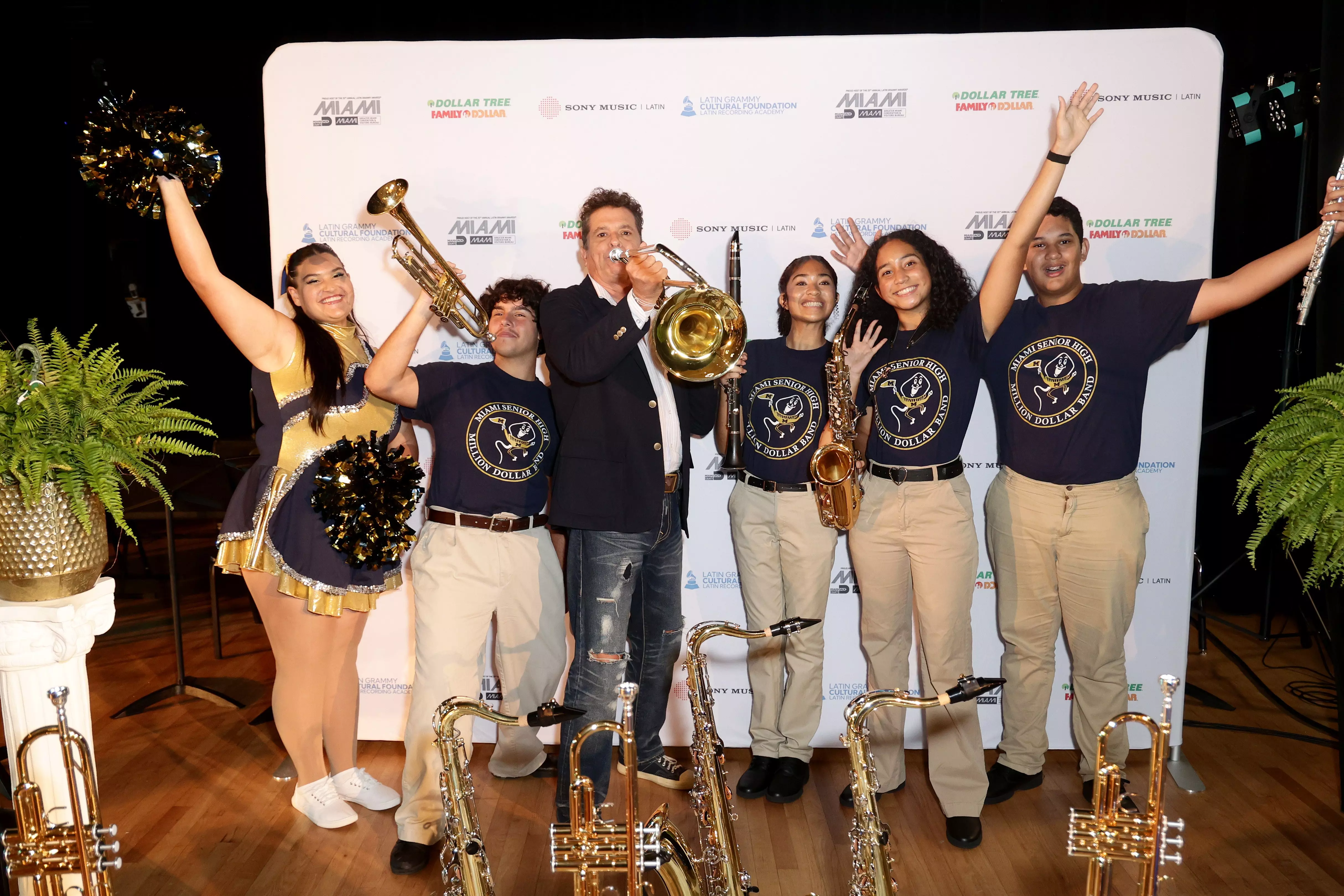
Behind The Scenes At Latin GRAMMY Week 2024: Inside VIP Celebrations & More
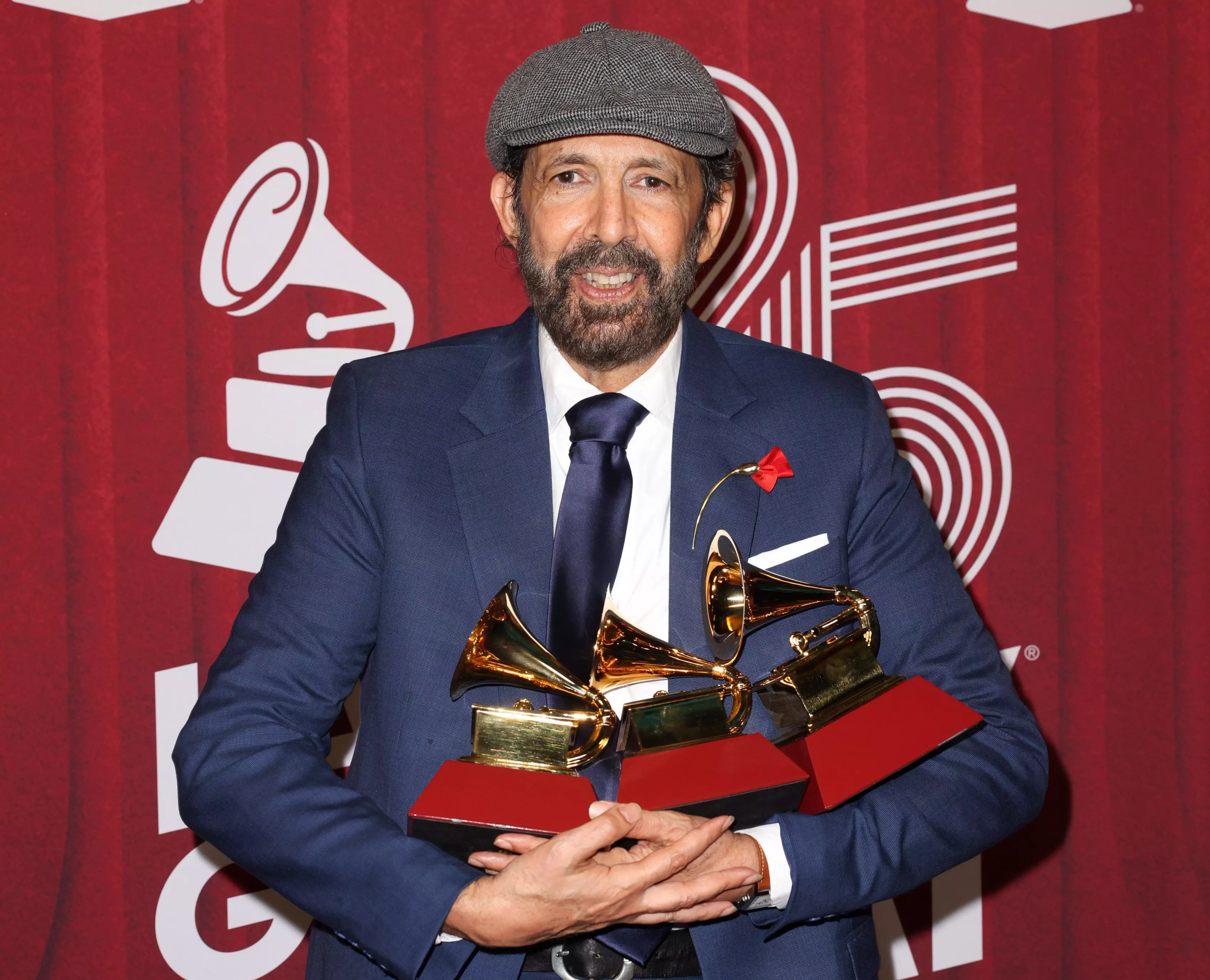
Juan Luis Guerra Sweeps The 2024 Latin GRAMMYs With 'Radio Güira'

Watch: Luis Fonsi Performs "Despacito" & Two More Of His Classics At The 2024 Latin GRAMMYs
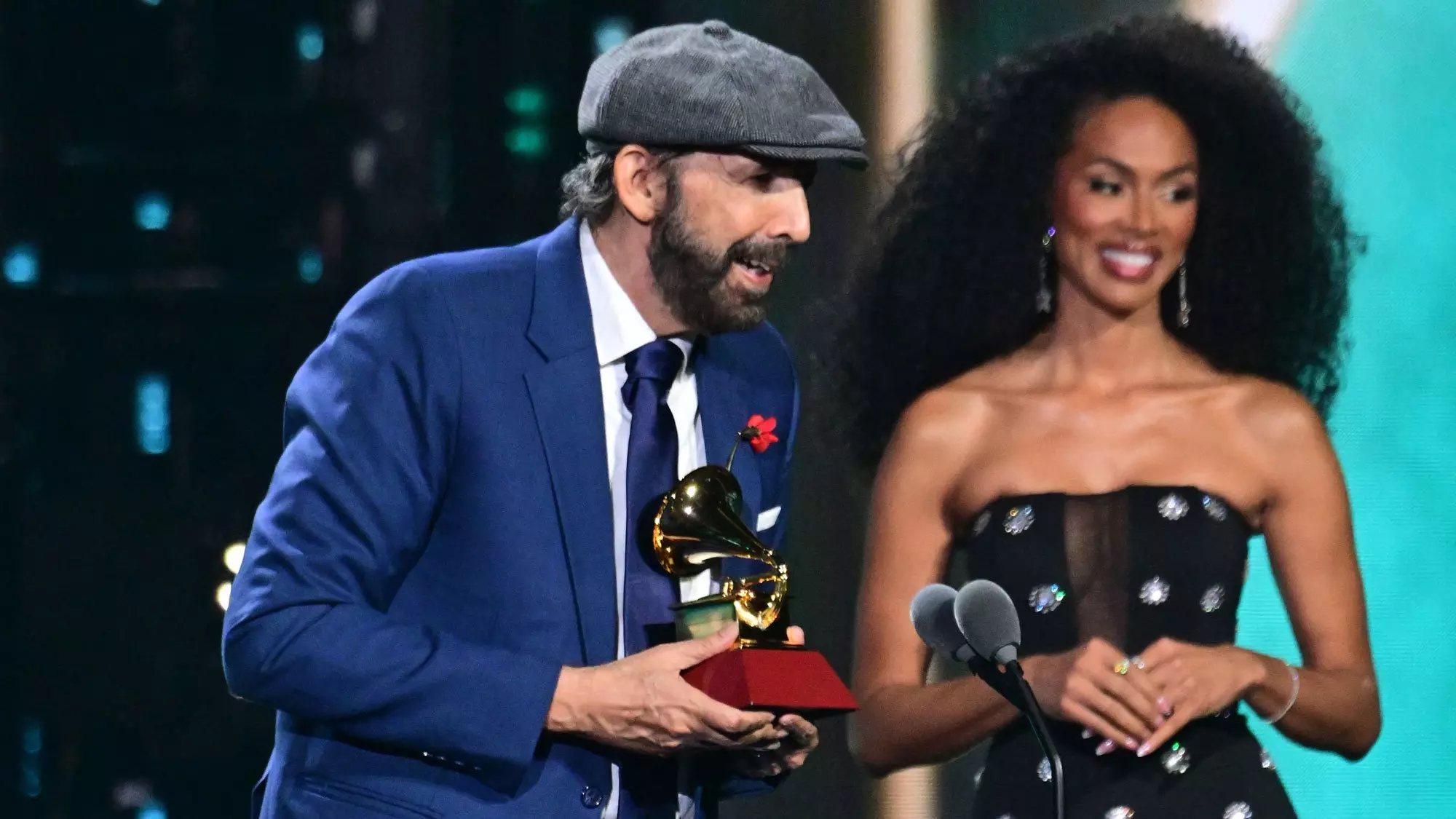
Watch: Juan Luis Guerra 4.40 Wins Album Of The Year For 'Radio Güira' | 2024 Latin GRAMMYs
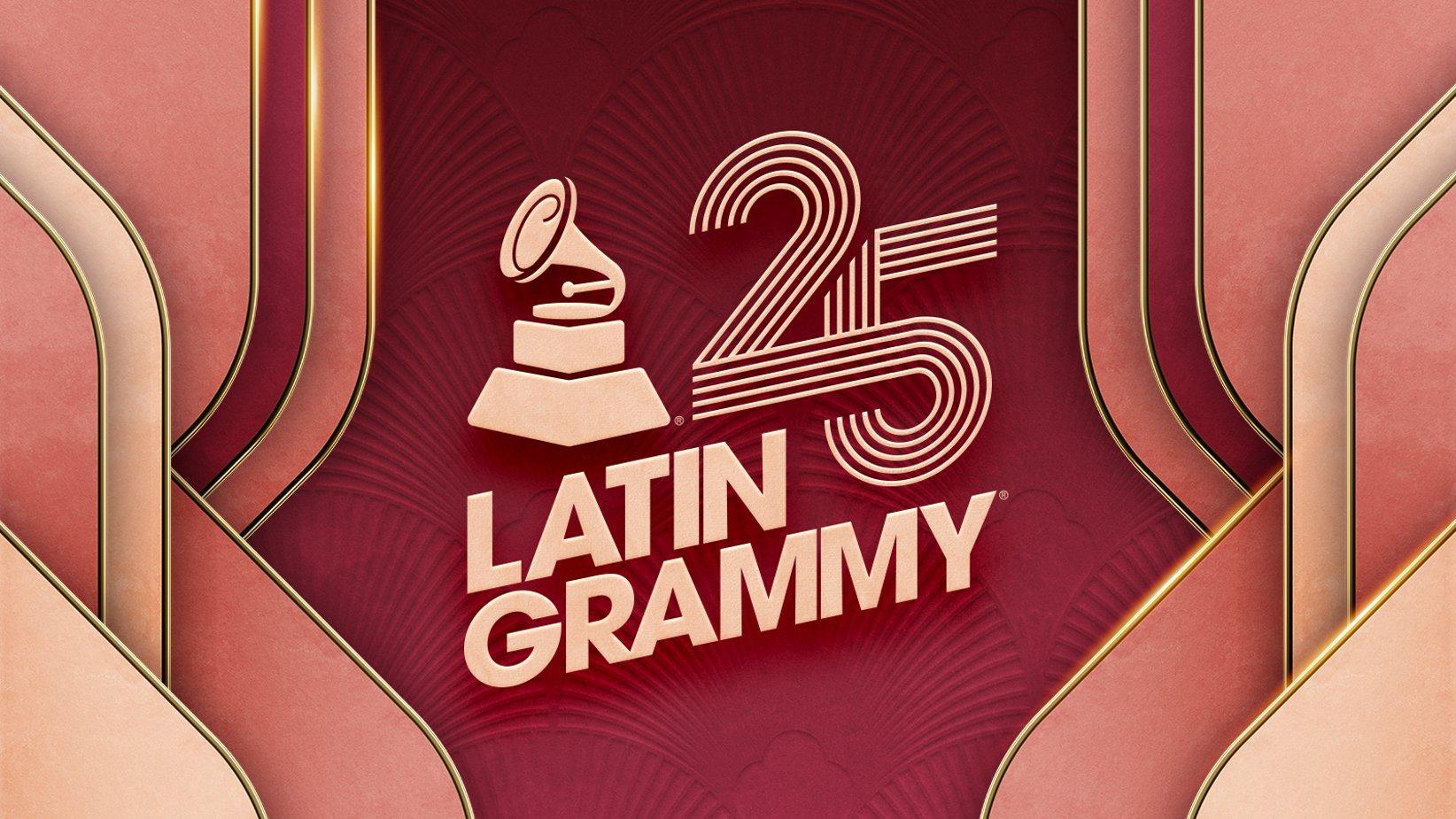
Graphic courtesy of the Latin Recording Academy
news
More Performers & Artists Announced For The 2024 Latin GRAMMYs: Juanes, Gloria Estefan, Rauw Alejandro, Mon Laferte, Nathy Peluso, Alejandro Sanz, Julieta Venegas & Many More
Marc Anthony will present a special salsa segment, and Andy García and Roselyn Sánchez will also return to showcase iconic moments from the last 25 years of the Latin GRAMMYs.
The Latin Recording Academy today announced additional performers and special artist presentations for the upcoming 2024 Latin GRAMMYs, which take place Thursday, Nov. 14, live in Miami: Current nominees Pepe Aguilar, Chiquis, Goyo, Mon Laferte, Nathy Peluso, and Rauw Alejandro, as well as previous Latin GRAMMY nominees Alejandro Sanz, Gloria Estefan, Juanes, and Julieta Venegas, have been added.
Additionally, salsa music icon Marc Anthony will executive-produce a special salsa segment during the 2024 Latin GRAMMYs, with musical direction from Sergio George.
GRAMMY winner Andy García and Latin GRAMMY nominee Roselyn Sánchez will also return to showcase iconic moments from the last 25 years of the Latin GRAMMYs and celebrate this milestone with the Latin Recording Academy.
Read More: 2024 Latin GRAMMYs: See The Full Nominations List
Previously announced performers and artists also include Ángela Aguilar, Leonardo Aguilar, Christian Alicea, Anitta, Edgar Barrera, Becky G, David Bisbal, Jon Bon Jovi, Eladio Carrión, DARUMAS, Oscar D’León, Álvaro Díaz, DJ Khaled, Emilia, Alejandro Fernández, Luis Figueroa, Luis Fonsi, Leonel García, Grupo Frontera, Grupo Niche, Juan Luis Guerra, Tiago Iorc, Joe Jonas, Carín León, Tito Nieves, Danny Ocean, Pitbull, Quevedo, Reik, Carlos Rivera, Elena Rose, Ela Taubert, The Warning, Myke Towers, Trueno, and Kali Uchis, as well as the 2024 Latin Recording Academy Person of the Year, Carlos Vives.
Pepe Aguilar is nominated for Best Ranchero/Mariachi Album, and Chiquis received a nomination for Best Banda Album. Goyo earned a nomination for Best Alternative Song, while Mon Laferte received three nominations including Record Of The Year and Album Of The Year. Marc Anthony has two nominations for Best Salsa Album and Best Short Form Music Video, and Nathy Peluso is nominated in three categories including Best Rap/Hip Hop Song, Best Alternative Song and Best Long Form Music Video. Rauw Alejandro received a nomination for Best Reggaeton Performance.
The 2024 Latin GRAMMYs, officially known as the 25th Latin GRAMMY Awards, marks the 25th anniversary of the Latin GRAMMY Awards, a massive milestone for both the Latin Recording Academy and the Latin GRAMMY Awards, and a return to Miami. The 2024 Latin GRAMMYs will debut two new Latin GRAMMY categories: Best Latin Electronic Music Performance and Best Contemporary Mexican Music Album.
Ahead of the 2024 Latin GRAMMYs, the Latin Recording Academy will host the official Latin GRAMMY Week 2024, a weeklong celebration comprising multiple events throughout Miami-Dade County. Marquee events at Latin GRAMMY Week 2024 include Leading Ladies of Entertainment; the Best New Artist Showcase; Special Awards Presentation; Nominee Reception; the Latin Recording Academy Person of The Year gala honoring 18-time Latin GRAMMY winner and two-time GRAMMY winner Carlos Vives; and the Latin GRAMMY Premiere preceding the 2024 Latin GRAMMYs telecast in which the majority of the night's awards will be awarded.
Additionally, the Latin Recording Academy is celebrating the 25th anniversary of the Latin GRAMMYs via a series of exhibits throughout 2024 held at the Paley Museum in New York City, the GRAMMY Museum in Los Angeles, and the Gary Nader Art Centre in Miami. Enrique "Kike" Congrains, who was recently announced as the 2024 Latin GRAMMYs official artist, is currently displaying his work at the exhibit hosted at Miami's Gary Nader Art Centre.
Learn more about how the Latin GRAMMYs have honored and elevated Latin music and its creators across the past 25 years and listen to the 25 songs that have defined the Latin GRAMMYs. For more information about the 2024 Latin GRAMMYs, read this year's official program book and shop the Latin GRAMMY 25th anniversary merchandise collection.
The 2024 Latin GRAMMYs take place Thursday, Nov. 14, and will air live from the Kaseya Center in Miami. The three-hour telecast, produced by TelevisaUnivision, will air live on Univision, UniMás, Galavisión, and ViX beginning at 8 p.m. ET/PT (7 p.m. CT), preceded by a one-hour pre-show starting at 7 p.m. ET/PT.
Latest In Latin Music, News & Videos

10 Meaningful Moments From The 2024 Latin GRAMMYs: Karol G's Heartfelt Speech, Tributes To Late Legends & More

Behind The Scenes At Latin GRAMMY Week 2024: Inside VIP Celebrations & More

Juan Luis Guerra Sweeps The 2024 Latin GRAMMYs With 'Radio Güira'

Watch: Luis Fonsi Performs "Despacito" & Two More Of His Classics At The 2024 Latin GRAMMYs

Watch: Juan Luis Guerra 4.40 Wins Album Of The Year For 'Radio Güira' | 2024 Latin GRAMMYs
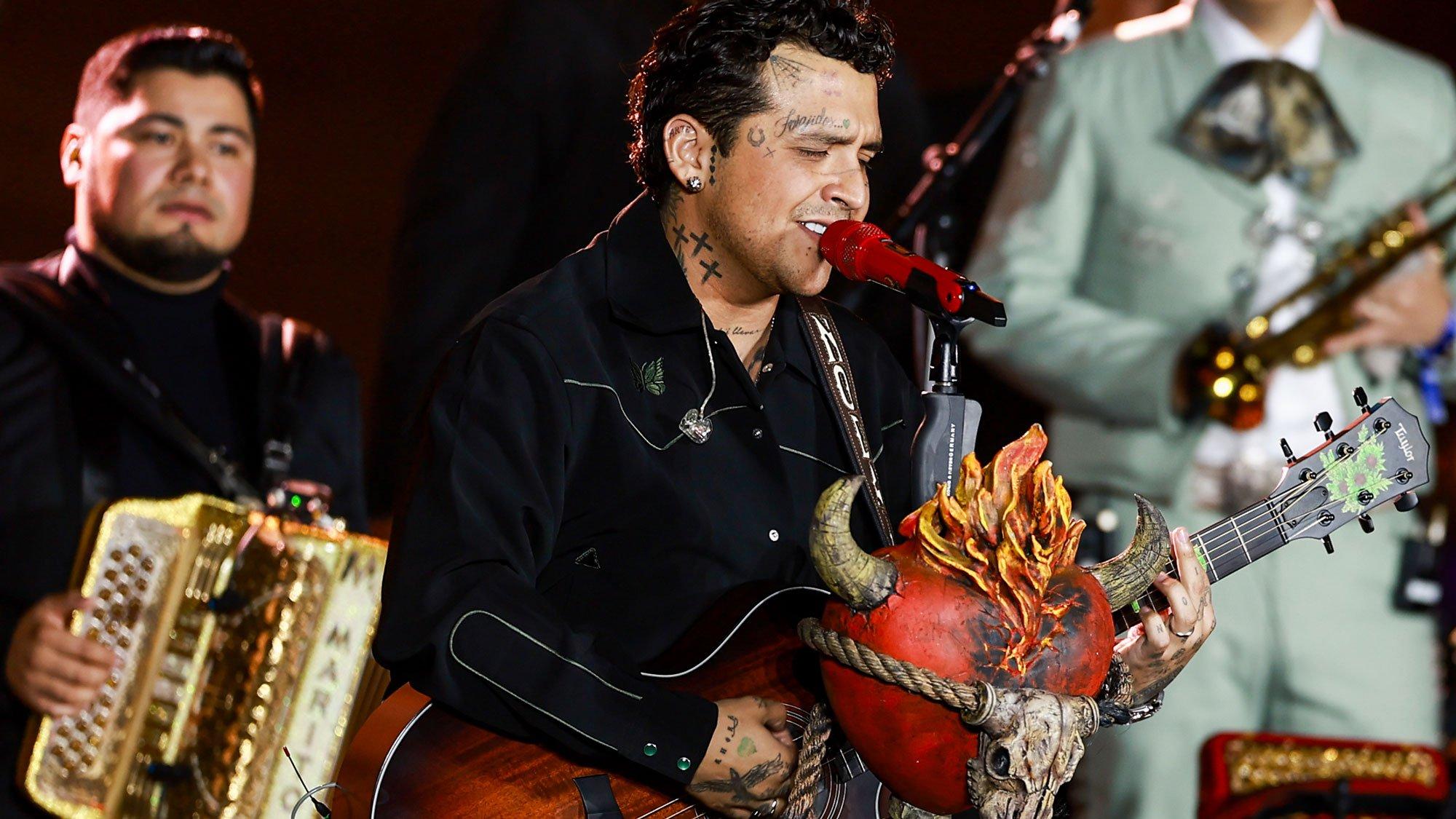
Photo: Alberto Rodriguez for The Latin Recording Academy
news
Christian Nodal Captivates In Latin GRAMMY Acoustic Session Performance At GRAMMY Museum
The Latin GRAMMY Acoustic Session was held in Los Angeles, where the GRAMMY nominee and six-time Latin GRAMMY winner captivated audiences with stripped-down performances of his hit songs.
Latin GRAMMY-winning artist Christian Nodal brought his unique blend of mariacheño music to an select audience at the GRAMMY Museum in Los Angeles on Oct. 16, as part of the 2024 Latin GRAMMY Acoustic Sessions. With just his guitar, a few accompanying musicians, and his powerful voice, Nodal delivered a deeply personal performance that celebrated the heart and soul of música Mexicana.
The evening featured a carefully curated setlist, including crowd favorites like "Bandolebrios," "La Intención," and "Quédate." Nodal's stripped-down versions highlighted his masterful storytelling and connection with his roots, making the night truly unforgettable.
"We are grateful to Christian Nodal for his support of our Academy and for sharing his artistry as part of our road to the 25th Annual Latin GRAMMYs," said Manuel Abud, CEO of The Latin Recording Academy. "Christian has played a pivotal role within our community and has contributed to the rise of the Regional Mexican genre."
The Latin GRAMMY Acoustic Sessions are a series of invitation-only events held throughout the U.S. and internationally, offering fans and Academy members an exclusive opportunity to witness performances by some of Latin music's most talented artists. Christian Nodal's performance at the GRAMMY Museum highlighted his dedication to the craft and his connection with his fans, creating an intimate atmosphere where his music could shine.
Nodal also took a moment to thank The Latin Recording Academy for their continuous support of music creators and their contributions to music education. "This acoustic was put together with a lot of love," Nodal shared. "Thank you for this opportunity to do what we love most: music. Long live music!"
A Rising Star Of Música Mexicana
Christian Nodal has emerged as a major force in música Mexicana, blending mariachi and norteño sounds to create his signature style, "mariacheño." At just 25 years old, Nodal has already won six Latin GRAMMY Awards and received three GRAMMY nominations.
His recent collaborations, such as the urban-infused hit "Botella Tras Botella" with Gera MX, demonstrate his ability to both honor and redefine traditional Mexican music. Throughout his career, Nodal has worked with renowned artists like Ricky Martin, Christina Aguilera, Peso Pluma, and Andrea Bocelli.
More Latin GRAMMY Acoustic Sessions
The Latin GRAMMY Acoustic Sessions have become a cornerstone of The Latin Recording Academy's efforts to elevate Latin music, offering an up-close experience with both established icons and emerging talent. Initially launched as in-person events for small audiences, the sessions have since expanded to include a global digital franchise, ensuring Latin musical excellence is accessible to all.
The Acoustic Sessions celebrate the diversity of Latin genres, and previous sessions have featured artists from a wide range of musical backgrounds. As Christian Nodal took his place among the iconic performers who have graced the stage, it was clear that his voice and vision continue to shape the future of Latin music.
Latest Latin Recording Academy News & Initiatives

10 Meaningful Moments From The 2024 Latin GRAMMYs: Karol G's Heartfelt Speech, Tributes To Late Legends & More

Behind The Scenes At Latin GRAMMY Week 2024: Inside VIP Celebrations & More

Juan Luis Guerra Sweeps The 2024 Latin GRAMMYs With 'Radio Güira'

Watch: Luis Fonsi Performs "Despacito" & Two More Of His Classics At The 2024 Latin GRAMMYs

Watch: Juan Luis Guerra 4.40 Wins Album Of The Year For 'Radio Güira' | 2024 Latin GRAMMYs
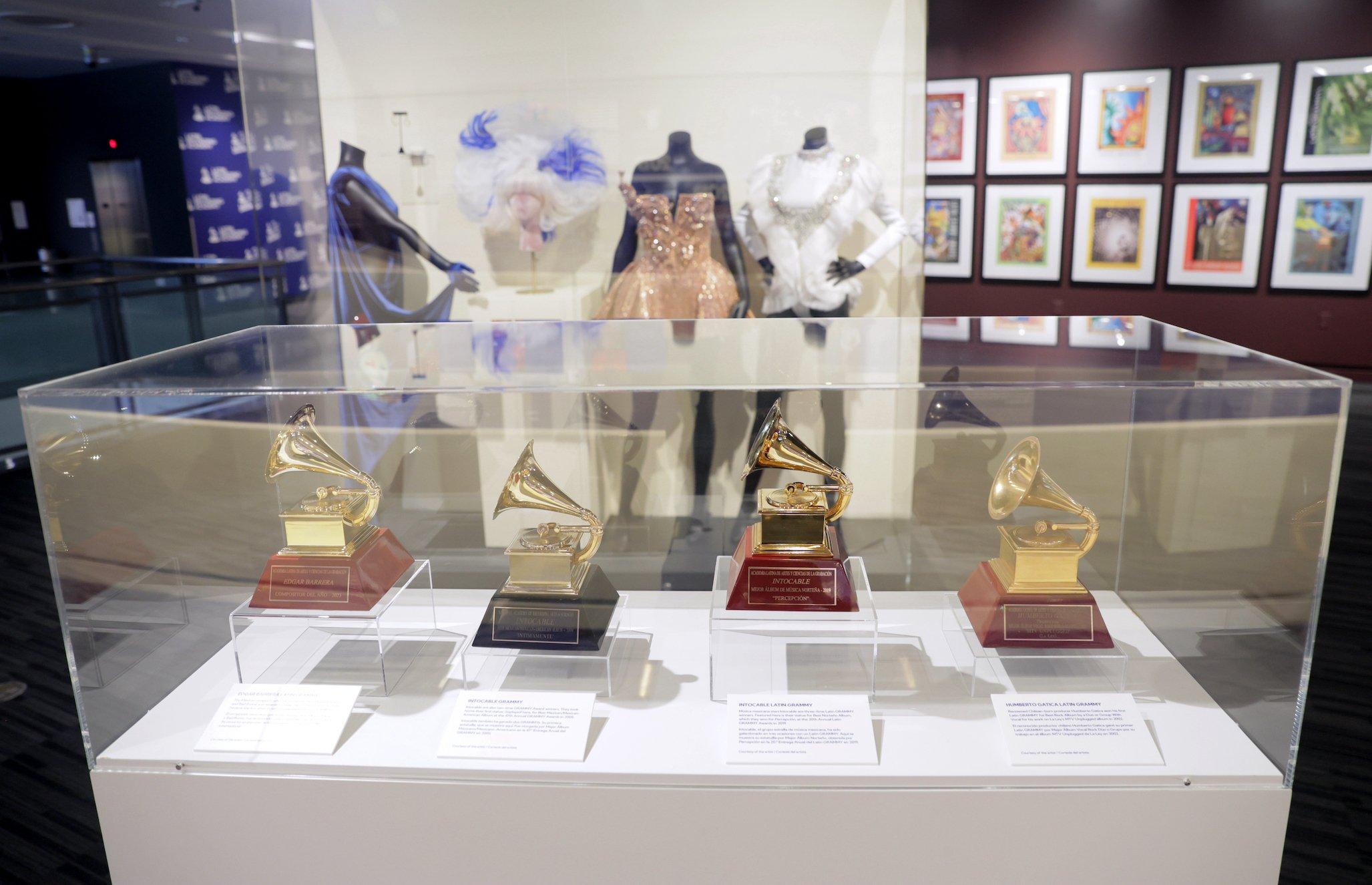
Photo: Rebecca Sapp
news
Inside The Latin GRAMMYs Exhibit At The GRAMMY Museum: Karol G’s History-Making Moments, Rosalia’s Iconic First Red Carpet Look & More
Get a glimpse of one of the Latin Recording Academy’s three exhibits celebrating the Latin GRAMMYs’ 25th anniversary — and highlighting the biggest onstage, backstage and red carpet moments.
To celebrate 25 years of the Latin GRAMMY Awards, the Latin Recording Academy opened a new exhibit at the GRAMMY Museum in Los Angeles on Sept. 19. The entire second floor of the museum is dedicated to capturing the growth of Latin music that has gone hand-in-hand with the Latin GRAMMYs through awards, artifacts, outfits, and instruments from previous winners and nominees like Shakira, Karol G, Peso Pluma, Juan Luis Guerra, Celia Cruz, and many more.
"Today, Latin artists are crafting pop culture, influencing everything, and breaking all the charts," Latin Recording Academy CEO Manuel Abud tells GRAMMY.com. "For the Latin Recording Academy, it's been a privilege to be with them on this journey, and this exhibit tries to bring this journey closer to the people. For us, this is an attempt to bring this journey and this legacy closer to the audience."
The newly opened exhibit at the GRAMMY Museum, officially named Latin GRAMMYs 25: A Legacy of Musical Excellence, is one of three that the Latin Recording Academy is presenting as part of the 25th anniversary of the Latin GRAMMYs celebration happening throughout this year, all of which will highlight the magic of the Latin GRAMMYs. The Paley Museum in New York City will host its exhibit, which opened Sept. 13, and runs through Nov. 3; the exhibit at Miami's Gary Nader Art Centre will open Sept. 26 and run through Dec. 20. The GRAMMY Museum's exhibit closes Dec. 18.
The series of multi-city exhibits leads up to the 2024 Latin GRAMMYs, which officially mark the 25th anniversary of the Latin GRAMMY Awards. Taking place Thursday, Nov. 14, in Miami, the 2024 Latin GRAMMYs will debut of a new field and two new categories: Best Latin Electronic Music Performance, housed within the new Electronic Music field, and Best Contemporary Mexican Music Album. Ahead of the 2024 Latin GRAMMYs, the Latin Recording Academy will host the official Latin GRAMMY Week 2024, which includes multiple events throughout Miami-Dade County including the 2024 Latin Recording Academy Person of the Year gala, which this year honors 18-time Latin GRAMMYs winner and two-time GRAMMY winner Carlos Vives, and the 2024 Special Awards Presentation.
Ahead of the GRAMMY Museum’s exhibit opening, Abud and Jasen Emmons, Chief Curator and Vice President of Curatorial Affairs of the GRAMMY Museum, took GRAMMY.com on a tour. Below, learn more about the GRAMMY Museum's monumental, history-filled display.
Learn more about the Latin Recording Academy and the GRAMMY Museum’s Latin GRAMMYs 25: A Legacy of Musical Excellence exhibit.
All photos by Rebecca Sapp.
A Timeline Of Latin GRAMMY Milestones
When entering the second floor of the GRAMMY Museum, one of the walls is covered with a giant timeline of major moments and milestones from the Latin GRAMMYs. The timeline starts with the 1st Annual ceremony in 2000, where Ricky Martin, Celia Cruz, and Gloria Estefan paid tribute to mambo legend Tito Puente, who had passed away a few months prior.
From there, moments highlighted include Luis Fonsi's performance of "Despacito" in 2017 with Diplo, Bomba Estéreo and Victor Manuelle, and Bad Bunny's win for Best Urban Album in 2019 where he advocated for more respect for reggaeton music and its artists. Edgar Barrera, who won the first Songwriter Of The Year award at last year's ceremony, also has his history-making Latin GRAMMY on display. The timeline not only shows the growth of the awards, but its impact on Latin music going mainstream.
"We created a platform for new artists to evolve and to present their craft, but also a way to celebrate established artists," Abud says as he looks at the timeline. "I think the beauty here is that we celebrate both at the same time that we are nurturing the next generation [or artists]. I love to see an artist like Karol G be Best New Artist in 2018 and winning Album Of The Year in 2023 and breaking all the records. It's the concept of how we bring it all full circle."
Read More: 2023 Latin GRAMMYs: Karol G Wins Album Of The Year For 'Mañana Será Bonito'
The Latin GRAMMY Awards By the Numbers
There's also a few more giant graphics on the other walls of the exhibit that are informational and educational. One graphic — which could be useful for either the GRAMMYs or Latin GRAMMY Awards — explains the difference between the Song Of The Year and Record Of The Year categories; another graphic shows the legacy of the Latin GRAMMYs by the numbers. The number 18 is shown next to Eduardo Cabra, who has the most wins for a producer, while his former Calle 13 associate, Residente, is highlighted for the most wins by a male artist with 28. Meanwhile, 2006 is shown next to Shakira's name for the ceremony where she made history as the first woman to win Record Of The Year, Song Of The Year, and Album Of The Year.
"I would like for visitors to feel the emotions because music is all about the emotions," Abud says. "I would like for them to go through the journey and remember what they were doing in 2006 or 2016, for example. I hope this exhibit brings them memories and gets them excited about the future. It's a combination of celebrating our past, but also enjoying the present, and preparing for the future."
The Diversity Of Latin Music Through Instruments
Another way the GRAMMY Museum's Latin GRAMMYs exhibit is hoping to educate visitors is through the instruments on display. Mexican group Intocable loaned a series of instruments that highlight the sounds of música Mexicana, including the bajo sexto guitar, the accordion, and a Djembe drums.
To highlight other genres in Latin music as well, Juan Luis Guerra loaned a güira, which is used in his merengue with "Punta Cana" written across it. The drums that Sheila E. played during her performance with Guerra at the 8th Annual Latin GRAMMYs are also present. The instruments exemplify not only different genres, but also different Latin cultures and countries.
"We really wanted to show a number of different instruments that we used in Latin music, like timbales or bajo sexto because for many people they may have heard them, but they haven't seen them before," Emmons says. "It's fun for people to be able to go, 'Oh! That's what that looks like, so it's making that sound.' We're really always trying to have that educational element to what we do."
Iconic Performances Revisited
The history of career-defining performances at the Latin GRAMMYs is captured in the fashion at the exhibit.
The colorful spirit of Celia Cruz, who passed away in 2003, is captured in a white and blue wig at the exhibit. The Cuban legend wore the wig during the 2002 Latin GRAMMYs — her last televised performance.
The outfits on display also further exemplify the diversity of Latin music. Mexican icon Pepe Aguilar's traditional charro suit is next to Peso Pluma's Givenchy and Alexander McQueen outfit from last year's ceremony that exemplifies his more urban approach to música Mexicana. Rauw Alejandro, who has gone from reggaeton hit-maker to global pop star, mixed both worlds with his red-hot Enfants Riches Déprimés look at last year's ceremony. Rosalía's white bodysuit from her flamenco-infused debut on the Latin GRAMMYs stage in 2018 is also on display.
"It's fun to see the growth of both Latin music, but also the Latin GRAMMYs," Emmons says. "It's extraordinary when you think in just 25 years how massive it's become and incredibly exciting. It was really fun to go through that [legacy of the Latin GRAMMYs] and figure out what were those moments that helped expand awareness of this and celebrate it."
Red Carpet Fashion At The Latin GRAMMYs
The iconic fashion of the Latin GRAMMY Awards isn't only limited to the performances. On the red carpet, many nominees and winners have made statements with their outfits.
One standout fashion moment in particular at the exhibit is Mon Laferte's purple suit at the 2021, where she proudly flaunted her pregnancy at the time. Karol G's metallic Balmain dress from last year's ceremony — where she later won Album Of The Year — is another stunning highlight among the outfits.
Barrera's fashion-forward suit that he wore during his historic Songwriter Of The Year win in 2023 is also on display. Beatriz Luengo, who won Song Of The Year for the Cuban protest anthem "Patria o Vida" in 2021, paid tribute to Celia Cruz with a blue gown that had the late legend's face emblazoned on it.
"The biggest thing I want is for visitors to go away saying, 'I want to listen to these artists,' if they haven't already," Emmons says. "Also, to have more appreciation for the artistry, and the showmanship because a lot of what we have on display are some of the performance outfits, red carpet outfits, and amazing style. At the heart of this exhibit is to inspire people to go discover artists that maybe they haven't listened to in awhile, or they never heard of before."
Latest Latin Recording Academy News & Initiatives

10 Meaningful Moments From The 2024 Latin GRAMMYs: Karol G's Heartfelt Speech, Tributes To Late Legends & More

Behind The Scenes At Latin GRAMMY Week 2024: Inside VIP Celebrations & More

Juan Luis Guerra Sweeps The 2024 Latin GRAMMYs With 'Radio Güira'

Watch: Luis Fonsi Performs "Despacito" & Two More Of His Classics At The 2024 Latin GRAMMYs

Watch: Juan Luis Guerra 4.40 Wins Album Of The Year For 'Radio Güira' | 2024 Latin GRAMMYs
